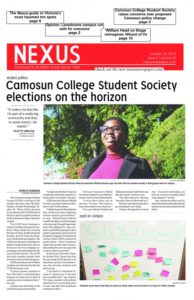Have you ever fallen or hurt yourself on the uneven sidewalks of Lansdowne campus? I’m sure that a number of disabled students, staff, and guests on our campus have.
Imagine if you were blind or had another impairment, like myself. Yes, hi, it’s me: I’m the stroke girl! You may have seen me struggling with my stiff right leg and curled right arm at Lansdowne. This condition is the result of a stroke that I had when I was 16 caused by an arteriovenous malformation (AVM). I won’t bore you with my recovery stories, though; that isn’t what this article is about. This article is all about safety on our Lansdowne campus.
Last year, I fell on campus and landed hard as I tried to navigate the uneven sidewalks caused by the roots of overgrown trees. The accident was between the Paul Building and the Isabel Dawson Building. I was in shock and badly bruised; some students kindly helped me. I told my friends and family about my experience, and some said that I should complain to somebody. I felt embarrassed and ashamed. I thought I should choose another route and park my car in a different location to avoid another fall. The same sidewalk had almost caused me to fall on several other occasions.

For me, it was and still is a serious hazard. I cannot risk breaking my left arm or leg; the consequences of that would not be good. l now walk with my head down looking for unexpected obstacles. Last year I also saw a middle-aged, able-bodied woman take a very bad fall in the same location. She had blood on her face and was crying. I realized then that this sidewalk posed a hazard to everyone.
I reported this via email in the Camosun poll at the end of last term. I’m not sure if my concerns were directed to anyone with the authority to address this issue. This term, I’ve decided to reach out to college administration to voice my concerns and, hopefully, see some action that fixes this problem.
I recently sent emails to several college departments; I received a response from the college confirming awareness of the uneven sections of the ground in question. A scarifier machine was used last summer to grind down problem spots to create a smoother transition between sidewalk sections. Slabs of sidewalks are replaced on a case-by-case basis.
This might improve the sidewalks somewhat but certainly doesn’t effectively remedy the situation. Removal of the trees causing the problem and replacement of damaged walkways is the only full correction of the uneven sidewalks. There are no firm plans or timeline in place to perform this work. Essentially we have a safety issue that’s being treated with a Band-Aid solution.
The most surprising thing I found in my research was the Camosun Facilities Services’ mission statement, which says that “[Facilities Services] are focused on providing a safe, sustainable, comfortable and functional environment for students, staff and visitors.” Meanwhile, on the Interurban campus, Camosun has opened a $63.8-million building while students—both disabled and able-bodied—are treading cautiously on dangerous sidewalks to get to class on the Lansdowne campus.
It’s time for the college to get serious and think about the issues that hinder the quality of life at this campus.
